- About
- Visiting
- What’s On
- Venue hire
- Catalogues
- Collections
- 101 Treasures of Chetham’s
- Digital Resources
- The Flowers of Histories
- A Book of Hours from France
- The Manchester Scrapbook
- Thomas Barritt of Manchester
- Art Treasures Examiner of 1857
- Manchester Association for Constitutional Order
- The North Western Museum of Science and Industry: Some Reminiscences by Richard Hills
- Criminal Manchester
- The Cup of Destiny
- Athenaeum Souvenir
- Middle English Manuscripts
- Manchester and Liverpool of Today
- Hollingworth’s Mancuniensis
- Memoir of Cecil Wray
- William Seward’s Diary
- The Anti-Monopolist
- Fishwick’s History of Rochdale
- Knyvett’s Defence of this Realm
- Tractatus de Nigromantia
- Axon Ballads
- Printed Books & Ephemera
- Archives & Manuscripts
- Prints and Photographs
- Blog
- Support us
Harmonia Ruralis or an essay towards a Natural History of British Song Birds
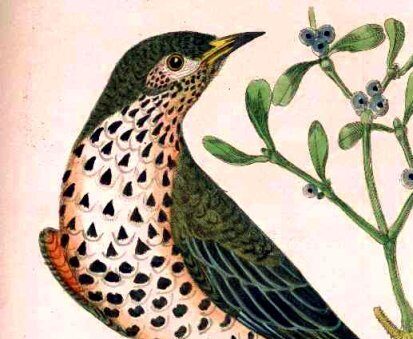
Birds and bindings
More than twenty years ago, in the dark and dusty underground reference stacks of Manchester Central Library, I first came across the two volumes of James Bolton’s illustrated book, Harmonia Ruralis. I was completely enchanted by his coloured images of British songbirds, their eggs, nests and habitat. The books were very fragile – the leather-covered spines and marbled boards had parted company and were held together with cotton tape but the pages were embossed with the 1851 stamp of Manchester Free Library. 1851 was the year in which Manchester became one of the first British cities to open a rates-supported library under the Public Libraries Act of 1850 and Bolton’s book had been selected as part of its first reference collection.
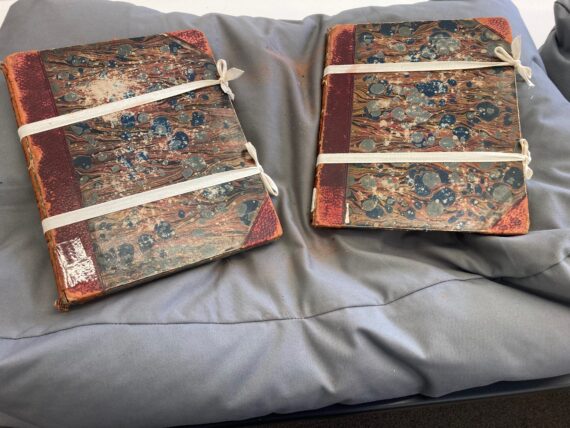
Image 1 – Manchester Central Library Copy
Many years later I joined Chetham’s library as a volunteer and was delighted to discover that the library also owned a copy of Harmonia Ruralis. There are- no provenance details but it was acquired after 1868 and has been rebound before any of the current staff were in post, but probably within the last twenty or thirty years. The book was among the first to feature in the online ‘101 Treasures of Chethams Library’.
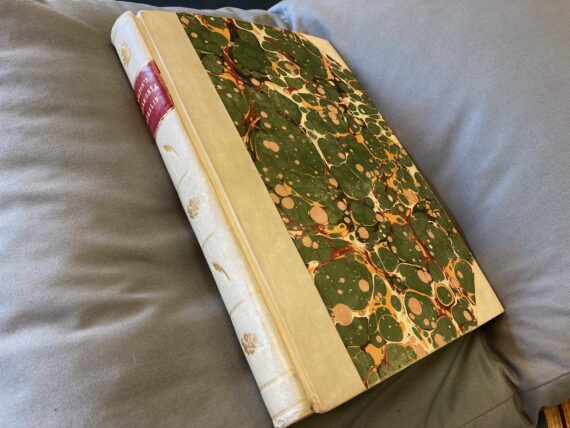
Image 2 – Chetham’s Library Copy
I recently decided to look more closely at the copies of Bolton’s book in Central Library and in Chethams and was intrigued to note significant differences in the hand coloured illustrations in the books. A check on ‘Library Hub Discover’ (the JISC database recording the catalogues of 203 UK and Irish academic, national & specialist library catalogues) revealed only 11 copies of Bolton’s book, three of which are held in Manchester – at Chethams Library, Manchester Central Library and the John Ryland’s Library at the University of Manchester.
A visit to the John Ryland’s library revealed that their copy of Harmonia Ruralis, in gold embellished crimson leather, was part of the 43,000 items in the Spencer Collection of books acquired by Henriqueta Rylands in 1892 and the coloured illustrations in this copy differed from both the Central Library and Chetham’s copies.
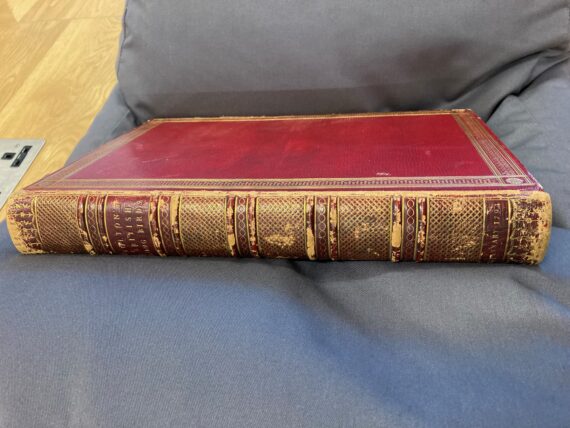
Image 3 – John Rylands Library Copy
Faithfully drawn, engraved and coloured after Nature.
James Bolton was a Northerner, from Halifax, where he lived all his life. He was originally a weaver (as recorded on his marriage certificate) but reinvented himself as a naturalist, artist and author. His older brother Thomas was also a naturalist and the two young men became part of a community which included scientists, collectors and wealthy and aristocratic men and women. Access to these groups was often through the supply of specimens for private collections – eggs, nests and bird ‘skins’ for taxidermy and also live birds which could be kept in ornamental cages.
Bolton states on the title page of his book Harmonia Ruralis that it is: ‘An Essay towards a Natural History of British Songbirds…illustrated with Figures the of Life, of the Birds, Male and Female in their most natural attitudes; their Nests and Eggs, Food, favourite Plants, Shrubs, Trees, &c.&c Faithfully drawn, engraved and coloured after Nature, By the Author on Forty Copper Plates’.
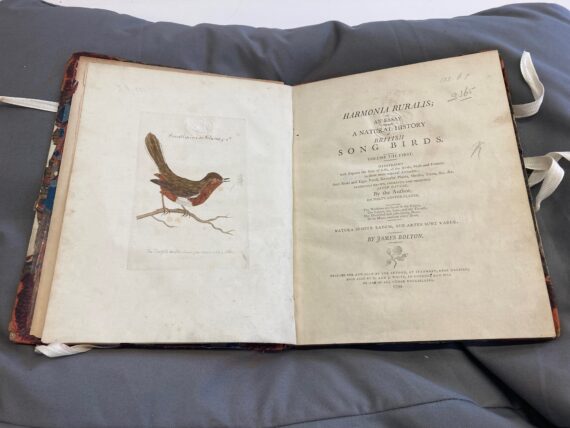
Image 4 – Harmonia Ruralis Title Page (Central Library Copy)
Harmonia Ruralis was Bolton’s third book, his first was on fungi and the second, Filices Britannicae…… on ferns. He had written about his methods in the introduction to the book on ferns: ‘The drawing and etching of the figures are performed wholely by my own hands, from a close and careful inspection of the plants. The employing of an engraver would have been attended with a considerable and certain expense; and as the reimbursement was very uncertain, I chose to undertake it myself, though I had never before practised the art of etching, that I might hazard only the loss of so much of my own time. The truth of the drawing in all figures may be relied on, and the definitions are faithful. For the execution of the plates in the engraving part, and for the stile (sic) in writing, I can make no other apology than of throwing myself on the humanity of my friends and the public. Halifax, August 16th, 1785.’
Turdus Musicus: the Song Thrush or Throstle
Despite Bolton’s claim that he had personally ‘drawn, engraved and coloured’ each and every image, it is obvious that there is a great deal of variation in the colouring, as these images of a thrush, taken from the three Manchester books, demonstrate. Note particularly the colour and brush patterns of the land upon which the bird is standing and the shades and shapes of the markings on his body.
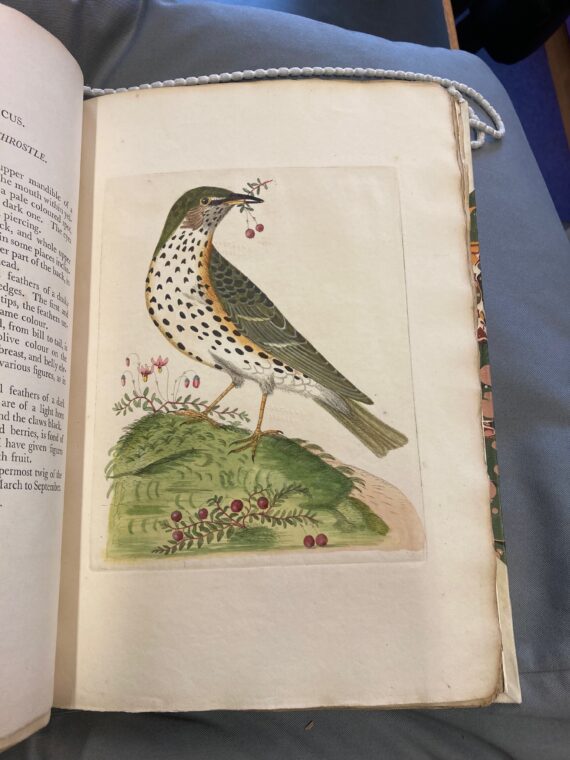
Image 5 – Chethams Thrush
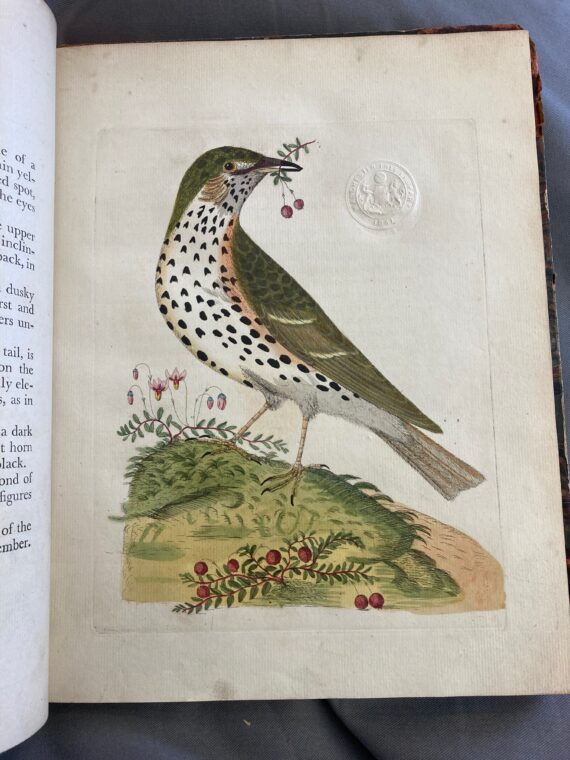
Image 6 – Central Library Thrush
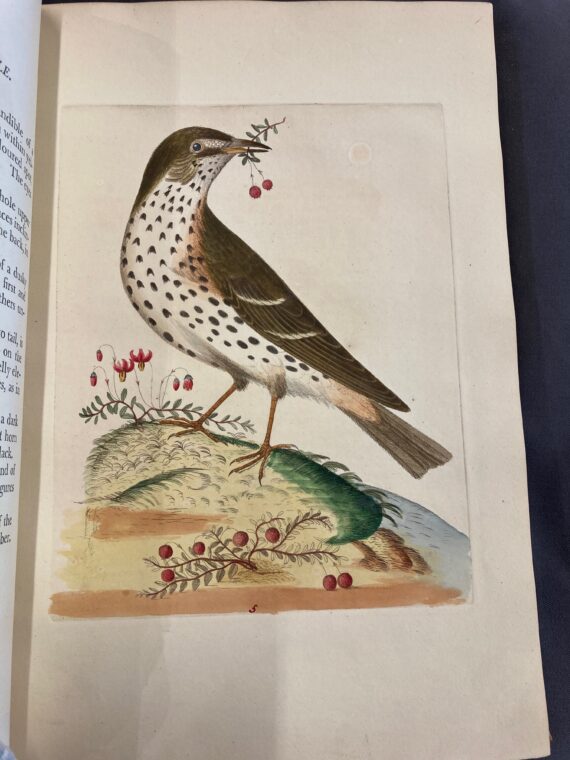
Image 6 – John Rylands Thrush
As I explored the three Manchester copies of Harmonia Ruralis I became increasingly curious about how the book had actually been made and I decided to approach Graham Moss of Incline Press to ask for his advice and insights. Graham is not only a practising printer but an expert on the history of printing and a very good friend to Chethams Library.
Graham commented that, as this was Bolton’s third book, he would have been familiar with the printing and publishing process. Before embarking on the printing of Harmonia Ruralis, he would have issued a pre-publication Prospectus, through his chosen booksellers, which advertised the book and potentially enabled customers to place an advance order. Graham also explained that at this period books were not ‘Edition Bound’ by the printer (in this case George Nicholson of Manchester) or the publisher (Bolton).
John Feather in his Dictionary of Book History, describes how the pages of text and illustrations would have been printed and then sold by the publisher to the bookseller ‘loose’ or in a simple trade binding. The customer could then have the pages trimmed and select a binding of their choice. Curiously the Chethams copy has untrimmed pages. Both the Chetham’s and John Rylands copies have volumes one (1794) and two (1796) bound together but the Central Library copy is in two separate volumes. Graham notes that the style, layout and motifs differ slightly between the two volumes, although both use Caslon which was a somewhat old-fashioned typeface but typical of a ‘provincial’ printer like George Nicholson.
The system for colouring the printed pages was what Graham describes as a ‘cottage industry’ probably organised by the printer and usually undertaken by young girls, and possibly their mothers, working in their homes. They would have needed a clean, well-lit space to work in and somewhere to hang the prints to dry. Bolton would have produced accurate coloured ‘model’ images which were distributed to them.
The reasons for variations in colour could have been due to differences in the amount of water used to mix the paint, and perhaps in the light conditions where the work was undertaken. The skill of the individual artists must also have contributed to the quality of the finished images. The copy at John Ryland’s is overall of a noticeably better quality than the other two in both colouring and brushwork. Is it possible that George John (1758-1834) 2nd Earl Spencer or his agent was able to select the best images or commission a specific artist? Graham suggests that the celebrated bibliographer Thomas Dibdin, who advised the Earl on his book collection and managed and catalogued his library, may have had a hand in this.
The British Ladies…..
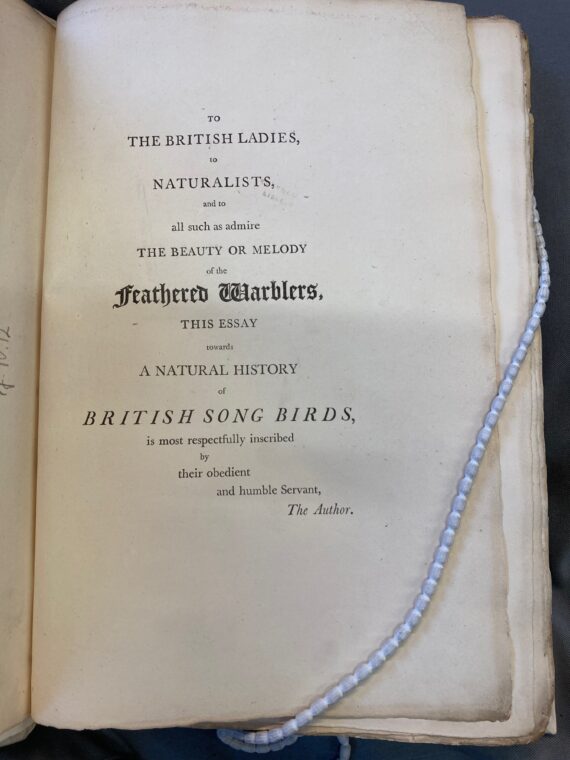
Bolton’s dedication is both charming and slightly mysterious: ‘To the British Ladies, to Naturalists and to all such as admire the Beauty or Melody of the Feathered Warblers’. It is highly likely that he is referring to two particular ladies – the Duchess of Portland and Anna Blackburne of Orford Hall near Warrington in Lancashire. However, that is another story ………
By Patti Collins

1 Comment
Susan Attridge
Fascinating and perceptive. A lot of work lies behind this informative piece.